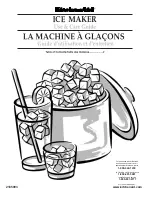
English
GREAT BRITAIN •
customer service
tel:
0845 300 9799
e-mail:
internet:
www.clasohlson.com/uk
Ver
. 20140424
Yoghurt Maker
Art.no 18-4601
Model MD-1000-UK
44-1088
MD-1000
Please read the entire instruction manual before using the product
and then save it for future reference. We reserve the right for
any errors in text or images and any necessary changes made
to technical data. In the event of technical problems or other
queries, please contact our Customer Services.
Safety
• Incorrect handling of this yoghurt maker could result in
personal injury.
• Always disconnect the yoghurt maker from the mains when
it is not in use, during assembly/disassembly or cleaning.
• The yoghurt maker may be used by children aged 8 or
over provided they have been instructed in the safe use
of the yoghurt maker and that they fully understand
the hazards or risks involved.
• Cleaning and maintenance may be carried out by children
aged 8 or over, but only under adult supervision. Ensure
that the yoghurt maker and its mains lead are kept out of
the reach of children under the age of 8.
• Switch the yoghurt maker off and disconnect it from
the mains before changing accessories or handling any of
the moving parts.
• The yoghurt maker may be used by persons with reduced
physical, sensory or mental capability, lack of experience
or knowledge which could jeopardise their safety, provided
they have been given proper supervision or instruction
regarding the safe use of the product and understand any
hazards involved.
• Never let children play with the yoghurt maker.
• Ensure that the product is used with the correct voltage.
Refer to the product manufacturer’s rating plate.
• To prevent electric shocks, the yoghurt maker and its mains
lead should be kept dry.
• Never lay the mains lead over hot surfaces, sharp edges or
corners.
• Always disconnect the yoghurt maker from the power
supply by holding and pulling the plug. Do not pull
the mains lead.
• Make sure that all parts are correctly assembled and that
the yoghurt maker is switched off before connecting it to
the power supply.
• Never run the yoghurt maker without any ingredients in
the container.
• Never use the yoghurt maker in close proximity to heat
sources.
• Only use the supplied parts and/or accessories.
• Only use the yoghurt maker for what it was designed for.
• The yoghurt maker is intended for indoor use only.
• Never use sharp objects to pry inside the yoghurt maker.
• Keep hands, hair, clothing and other loose objects away
from the yoghurt maker during use, as these can become
caught and cause injury.
• The mains lead should be checked regularly. Never use
the product if its mains lead or plug is damaged.
• The mains lead must be changed if damaged. This is to
prevent the risk of electric shock or fire and should only be
carried out by the manufacturer, authorised service facility or
a qualified tradesman.
Before using for the first time
• Hand wash all the detachable parts, the ladle, the lid and
the bowl before initial use.
• In order to prepare yoghurt, you will need a litre of milk and
some yoghurt bacteria culture.
Choice of milk
• Yoghurt can be made from milk of various fat contents;
Skimmed milk (less than 0.1 %), Whole milk (3.5 %) or even
other kinds of milk.
• Milk with a higher fat content, such as whole milk (full fat milk),
will give the yoghurt a firmer consistency and more flavour.
• It takes 5–10 hours to make yoghurt, depending on the type
of milk used and how you want it to taste. You should
experiment until you find a combination which meets
your taste.
Choice of bacteria culture
• From a shop-bought natural yoghurt with the longest best-
before date as possible (freshest).
• From a yoghurt you have made yourself.
• From a freeze-dried culture bought at a health food shop etc.
Operating instructions
Making the yoghurt
1. Heat the milk to 80–85 °C (to kill any other types of
unwanted bacteria cultures)
2. Allow the milk to cool down to: 40–45 °C and carefully mix
your yoghurt culture into the milk. If using natural yoghurt,
mix in about 100 ml yoghurt to 1 litre milk. Fold in carefully
with a spoon, do not whisk.
3. Pour the milk-yoghurt mixture into the bowl.
4. Put the lid on the bowl and place the bowl inside
the yoghurt maker.
5. Plug the yoghurt maker in and switch it on.
NOTE:
• Do not move the yoghurt maker while it is switched on.
• Avoid using the yoghurt maker in places which are very dry
or which are subject to strong vibrations.
Cooling the yoghurt
1. Remove the lid of the bowl to prevent drops of
condensation falling into the yoghurt.
2. Place the bowl of yoghurt in a fridge for at least an hour
before it is to be consumed. If you wait for 2 hours,
the yoghurt will be firmer.
3. Never store the yoghurt in the fridge for longer than 8–10 days.
4. Never place the entire yoghurt maker in the fridge, only
the detachable parts.
Care and maintenance
• Always unplug the yoghurt maker before cleaning it.
• Never immerse the heating unit in water or expose it to
moisture. Clean this part by wiping it with a soft, damp cloth.
• The detachable parts should be hand washed.
Disposal
This product should be disposed of in accordance with local
regulations. If you are unsure how to proceed, contact your
local council.
Specifications
Voltage
220–240 V
Wattage
9 W
Bowl capacity
1 l























